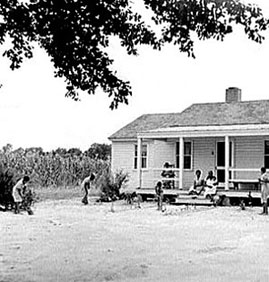
“Children Sweeping Yard in South Carolina.” Taken in June 1939, this photo from the Library of Congress shows four African American children sweeping the yard in front of their South Carolina tenant house.
Important features of the swept yard were summarized by archeologists Barbara Heath and Amber Bennett in their 2000 article, "The Little Spots Allow’d Them: The Archeological Study of African American Yards.” They note that African, Caribbean, and African-American yards today serve as locations for spiritual and artistic expression. Swept yards are common features of West and Central African domestic compounds, and the practice of sweeping carries spiritual as well as social dimensions. Among the Bakongo of Central Africa, “sweeping is an ordinary ritual gesture for ridding a place of undesirable spirits” in a landscape populated by day with the ghosts of witches and others who have not been accepted into the villages of the dead, and by night with the ancestors. The authors note that this African practice of yard sweeping has continued into the 20th century among African Americans from rural Maryland to the hills of Jamaica. Sweeping is explained as a way to keep the yard free from insects and provide a comfortable area for social activities, but may preserve spiritual meaning as well.